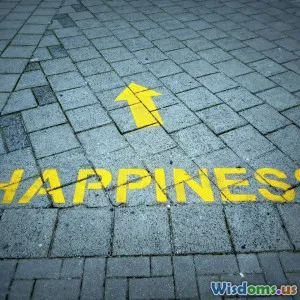
Why Communication Breakdowns Happen and How Counseling Can Fix Them
7 min read Explore why communication breakdowns occur and discover how counseling offers practical solutions to restore understanding and connection. (0 Reviews)
Why Communication Breakdowns Happen and How Counseling Can Fix Them
Communication forms the foundation of human interaction. Yet, surprisingly often, our attempts to relate, collaborate, or express ourselves result in misunderstandings or complete breakdowns in communication. These breakdowns can cause emotional pain, workplace inefficiency, and fractured relationships.
Understanding why communication breakdowns happen—and importantly, how counseling can effectively address them—is key to reconnecting and fostering healthier communication habits.
The Art and Science of Communication
At its core, communication is more than mere words; it is a complex dance of verbal messages, nonverbal signals, emotions, and context. According to the renowned psychologist Albert Mehrabian, in conveying feelings and attitudes, approximately 7% of the message pertains to spoken words, 38% to tone of voice, and 55% to body language. This underscores the multifaceted nature of communication.
Common Causes of Communication Breakdowns
-
Assumptions and Misinterpretations One of the main culprits is the tendency to assume intentions or meanings that may not exist. For example, a co-worker’s curt email response can be interpreted as dismissive or angry, though the sender might have simply been rushed.
-
Emotional Barriers When emotions run high—be it anger, fear, or hurt—people often communicate reactively rather than reflectively. This emotional charge can obscure the intended message.
-
Cultural and Language Differences In an increasingly globalized world, cultural background significantly impacts communication styles and expectations. A phrase acceptable in one culture may seem rude in another.
-
Lack of Active Listening Communication is bidirectional. When people fail to listen attentively, they miss nuances and key points, resulting in broken understanding.
-
Ineffective Communication Skills Sometimes individuals lack the vocabulary, confidence, or strategies to convey thoughts clearly, especially concerning sensitive or complex topics.
-
Technological Challenges With remote work and digital interactions, the absence of face-to-face cues often leads to misunderstandings.
Real-World Example: The Workplace Scenario
A survey conducted by the Institute for Corporate Productivity revealed that 86% of respondents cited ineffective communication as a primary source of workplace failures. For instance, unclear project instructions or lack of feedback can lead to costly mistakes.
How Counseling Addresses Communication Breakdowns
When routine efforts to resolve communication issues fail, counseling provides a structured and empathetic setting to diagnose and mend these breakdowns.
The Role of a Counselor: Neutral Facilitator and Guide
Counselors are trained to observe communication patterns, identify barriers, and create safe spaces where parties feel heard without judgment. For example, marital counselors help couples navigate sensitive topics by teaching respectful listening and expression.
Key Counseling Techniques to Improve Communication
-
Active Listening Exercises Participants practice fully focusing, understanding, responding, and remembering what the other says, improving mutual comprehension.
-
Conflict Resolution Strategies Counseling introduces constructive approaches like "I" statements, where individuals express feelings without blaming, reducing defensiveness.
-
Emotional Regulation Skills Clients learn to recognize and manage emotions that interfere with communication, changing reactive patterns into reflective dialogues.
-
Cultural Competency Awareness Counselors sensitize individuals to cultural factors influencing communication, fostering respect and adaptability.
-
Role-Playing and Simulation By rehearsing real-life difficult conversations, counseling develops confidence and clarity.
Evidence Supporting Counseling Effectiveness
A 2018 meta-analysis published in the "Journal of Communication Disorders" highlights significant improvements in communication satisfaction among couples and families participating in counseling. Moreover, workplace counseling and coaching initiatives have documented enhanced team collaboration and reduced conflicts.
Transformational Outcomes from Counseling
Consider the case of Sarah and Michael, recently married and struggling due to constant miscommunications about finances and household responsibilities. Through couples counseling, they learned to break down implicit assumptions and express needs explicitly. As a result, they report increased trust, satisfaction, and emotional intimacy.
In organizational contexts, counseling-driven communication workshops have transformed strained dynamics. A notable case involves a tech startup where founders experienced escalating communication tensions threatening the venture's survival. Targeted counseling fostered empathy, set clear communication protocols, and revitalized their partnership.
Practical Takeaways for All Readers
Whether in personal or professional realms, enhancing communication is universally valuable:
-
Acknowledge Imperfections: Understand that communication breakdowns are common and fixable.
-
Seek Professional Help Early: Counseling isn't a last resort; it is a proactive tool.
-
Practice Mindful Communication: Pay attention to tone, body language, and emotional context.
-
Cultivate Empathy: Put yourself in the other’s shoes to bridge gaps.
-
Leverage Feedback: Encourage open, honest dialogue.
Conclusion: Bridging the Chasms of Communication
Communication breakdowns arise from layered, complex causes—ranging from emotional barriers and assumptions to cultural differences and noisy mediums. Left unaddressed, they erode relationships, hinder progress, and increase frustration.
Counseling offers powerful, evidence-based strategies to heal these fractures. By fostering active listening, emotional awareness, cultural competency, and conflict resolution, counseling transforms challenging conversations into bridges of connection.
Ultimately, embracing counseling to fix communication breakdowns not only repairs dialogue but also nurtures greater understanding, respect, and resilience in the intricate dance of human interaction.
References:
- Mehrabian, Albert. "Nonverbal Communication." 1972.
- Institute for Corporate Productivity. "Communication Skills Impact on Workplace Success," 2020.
- Journal of Communication Disorders (2018). "Meta-analysis of Counseling Effects on Communication Satisfaction."
Interested in improving communication in your personal or professional life? Consider exploring counseling options in your area to take the first informed step towards clearer, compassionate communication.
Rate the Post
User Reviews
Other posts in Emotional Intelligence
Popular Posts
















